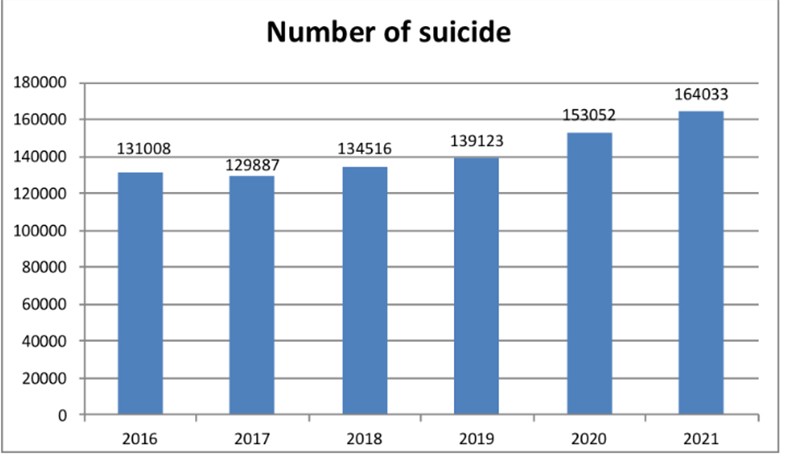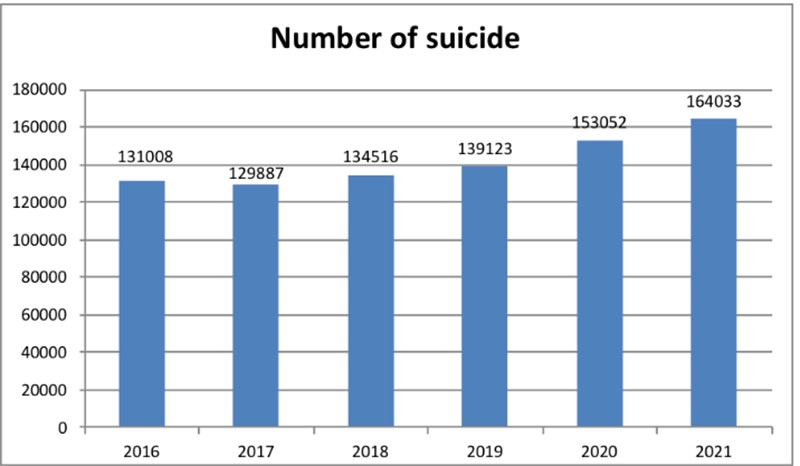 Suicides in India
Image: Pixabay
Suicides in India
Image: Pixabay
Suicides in India: A Silent Killer
In 2003, 10th September was chosen to be celebrated as World Suicide Prevention Day (WSPD). In collaboration with World Health Organization (WHO), the International Association for Suicide Prevention (IASP) uses this day to create awareness that suicide leading to premature deaths can be prevented. This article aims to present the overall picture relating to suicides happening in India.
Suicide is a serious public health problem that can negatively affect individuals, families, and communities. Every year, thousands of people commit suicide in India, but this has still been an overlooked problem. According to the data reported by the National Crime Records Bureau (NCRB), the rate of suicides was 12.0 during the year 2021.
Trends also show an upward slope in the case of suicides reported from 2016-2021, with an overall increment of 25.2 percent.
It is important to note that 2016-2017 has seen a decline in the cases of suicides in India from 131008 to 129887. After this break, India saw an increase in suicides yearly, with rates of 3.5 and 3.4 percent in 2017-18 and 2018-19, respectively. In 2019-20, the number of suicides in India had almost multiplied by three times, marking an increase of 10 percent. Furthermore, in 2020-2021, suicides have seen a rise of 7.1 percent.

According to NCRB data, central and south India has the largest percentage share of all suicides during 2021. Maharashtra has taken first place in the most suicides (22,207), followed by Tamil Nadu (18,925), Madhya Pradesh (14,965), West Bengal (13,500), and Karnataka (13,056), which accounted for 13.5, 11.5, 9.1, 8.2, and 8.0 percent of all suicides respectively.
The most vulnerable group
NCRB data shows most vulnerable age group to fall into the trap of suicide is 18 to 45 years. The 18-30 and 30 to below 45 years were the most vulnerable groups, accounting for 34.5 percent and 31.7 percent of suicides, respectively.
Daily wage earners committed the maximum number of suicides. In 2021, 31.7 percent of the total male victims were daily wage earners (37,751 out of 1,18,979), who accounted for 25.6 percent of all suicide victims (37,751 out of 1,64,033). A significant number of housewives' suicides account for approximately 14.1 percent of all suicide victims (23,179 out of 1,64,033) and 51.5 percent of all female victims (23,179 out of 45,026) in 2021.

Causes of Suicides
11 reasons are included in the report Accidental Deaths & Suicides in India published by NCRB to assess the causes of suicides in India. It reveals that the primary reason contributing to suicides in the country during 2016-21 is family problems and illness, which contributed 33.2 and 18.6 percent in 2021. Other causes such as drug abuse/addiction, marriage-related issues, love affairs, bankruptcy or indebtedness, unemployment, failure in the examination, professional and career problems, poverty and property dispute are also contributing to the suicides in India.
Role of COVID-19 in the rising number of suicides
The cases increased by 15.18 percent between the high peak of the COVID pandemic in 2019 and 2021. (As per the ADSI report)
The National Center for Biotechnology Information (NCBI) study found that COVID-related suicide (CRS) reports increased throughout the lockdown period. NCBI explained it as a healthy person visiting the doctor with fever and cold symptoms, and he is given drugs or a COVID-19 test and placed in isolation or quarantine. He then encounters avoidance, stigma, and prejudice from those around him, experiences extreme stress and commits suicide due to a feeling of helplessness or to protect his loved ones from infection.
Cause of being the highest share of Maharashtra
According to psychiatrist Dr Harish Shetty, the statistics have never increased by such a significant percentage. The total number of suicides has only slightly increased in the past by three to four percent, but last year, as a result of COVID-19, it rose by 10 percent, which is significant.
According to a police officer, the epidemic significantly influenced daily wage earners' livelihoods. It caused nearly all of them to commit suicide because they had lost their jobs.

Prevention
In India, an alarming number of people are suiciding, but it can be prevented with well-timed, evidence-based, and low-cost interventions (WHO).
The cause of suicide is multidimensional; hence its preventive measures need to be multidimensional to neutralise the motivation to commit suicide. All know that all things are interrelated, and a careful assessment of social factors contributing to the problem is required. Such as reducing alcohol consumption, unemployment, poverty, and domestic violence and improving social justice and social inequalities are essential to reducing the suicide rate in India.
Effective suicide prevention measures include a bolstered system for quality data on suicides (attempted and fatalities) from vital registries, hospital-based systems, and other surveys for developing policies and their subsequent monitoring. Prevention measures are reinforced by increased life-skill training and counselling in schools, workplaces, etc.
Governments may also take indirect prevention measures, as in many cases suicide is done with the help of pesticides, firearms, self-hanging, jumping off bridges and in front of trains. Policies regulate the use of pesticides, firearms, and the proper barricading of highly dangerous areas like bridges and railway tracks.
(The writer is an Academic Associate, IIM Ahmedabad, a business school located in Ahmedabad, Gujarat, India. The view expressed in the article is of the writer and not TWF)
Top Headlines
-
Health
Akhil Bharat Jaiguru Sampradaya and Omkarnath Mission volunteers care for terminally ill patients at Mahamilan Math hospice
November 05, 2025
-
Health
Ayurveda and Skin Health in the Modern Age
October 09, 2025
-
Health
MedSage expands footprint with new branch in Rampurhat
October 04, 2025
-
Health
Vijaya Diagnostic Centre inaugurates State-of-the-Art Centre featuring first advanced 3 Tesla MRI in Kolkata
September 11, 2025
-
Health
Ayurveda and the urban woman: Practical science for a healthier, calmer life
September 07, 2025
-
Health
Rotary Club of Belur strengthens Kolkata healthcare with donation to Ramkrishna Mission Seva Pratishthan
August 25, 2025
-
Health
Parampara Ayurveda founder Dr. Debabrata Sen shares wellness strategies for desk-bound professionals
August 08, 2025
-
Health
Kolkata: Mega health camp transforms lives in Ultadanga slum with free multi-specialty services
August 02, 2025
-
Health
Mass awareness of Ayurvedic medicines is needed: Parampara Ayurved founder Debabrata Sen
May 26, 2025
-
Health
Vijaya Diagnostic Centre inaugurates State-of-the-Art Centre featuring 3 Tesla MRI and 80-Slice CT in Bengal
May 22, 2025
